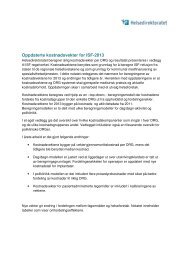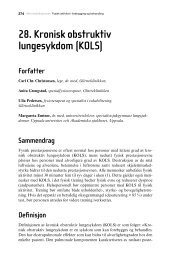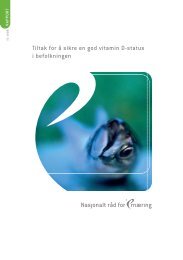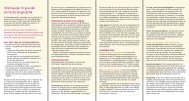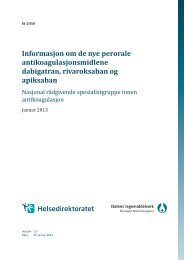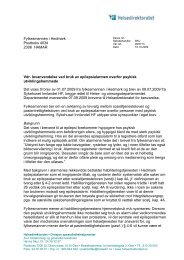Last ned - Helsedirektoratet
Last ned - Helsedirektoratet
Last ned - Helsedirektoratet
You also want an ePaper? Increase the reach of your titles
YUMPU automatically turns print PDFs into web optimized ePapers that Google loves.
Vedlegg 1: Sammendrag tatt fra den amerikanske<br />
rapporten: “Fetal Alcohol Syndrome: Guidelines for<br />
Referral and Diagnosis”<br />
Summary and future steps<br />
In 2002 CDC was congressionally mandated to develop diagnostic guidelines for FAS and<br />
other prenatal alcohol-related disorders and integrate them into medical and allied health<br />
education. With input from a SWG composed of clinicians and family and from the<br />
NTFFAS/FAE, scientific and clinical evidence was reviewed to develop guidelines that offer<br />
a balance between conservative and overly inclusive definitions of FAS. Criteria for<br />
conditions not meeting the clinical definition of FAS (e.g. ARND) were not established,<br />
because scientific evidence is insufficient at this time. Clinical and scientific research on FAS<br />
and those conditions resulting from prenatal alcohol exposure that do not meet the criteria for<br />
an FAS diagnosis is currently underway. These findings and advances will contribute to<br />
further refinement of the FAS criteria, and could potentially delineate additional diagnostic<br />
categories and criteria for conditions other than FAS. The development of these FAS<br />
guidelines is a continuous process. Efforts to develop and refine other diagnostic categories to<br />
identify FAS and related conditions need to continue.<br />
During this guidelines development process, several key issues emerged that deserve mention.<br />
1. More information on the neurodevelopmental effects of prenatal exposure to alcohol is<br />
needed. Particular emphasis should be placed on finding the unique aspects of FAS<br />
that will help differentiate it from other birth defects or developmental disabilities, or<br />
both.<br />
2. Efforts to improve the clinical assessment tools (e.g. facial and growth measures) used<br />
to diagnose FAS should continue, particularly in terms of racial and ethnic variations<br />
and age.<br />
3. All children should be scree<strong>ned</strong> for the possibility of an FAS diagnosis. As physicians<br />
and other allied health professionals become educated about this disorder, screening<br />
for FAS should become routine.<br />
4. Better communication between obstetricians, gynecologists and pediatricians is<br />
needed to improve documentation on prenatal alcohol use. This would help with the<br />
diagnosis of prenatal alcohol exposure in the child and could help identify women at<br />
risk for future alcohol-exposed pregnancies.<br />
5. Service agencies must provide a way to qualify children with FAS and related<br />
disorders who do not meet their traditional eligibility requirements.<br />
6. Further research and resources are needed to identify and treat women at risk for an<br />
alcohol exposed pregnancy.<br />
7. Awareness, both in the public and professional arenas, about the dangers of drinking<br />
alcohol during pregnancy and about FAS and how the condition affects children and<br />
their families is essential. A key avenue to avoiding FAS is active promotion of<br />
programs to increase awareness of the dangers of drinking alcohol during pregnancy<br />
and promotion of prevention activities that increase understanding of the risks of<br />
alcohol as well as the risks for an alcohol-exposed pregnancy.<br />
Over 30 years ago researchers first described FAS. Much has been lear<strong>ned</strong> about the disorder<br />
since that time, as in reflected in these guidelines. However, there is still much more to learn<br />
101





